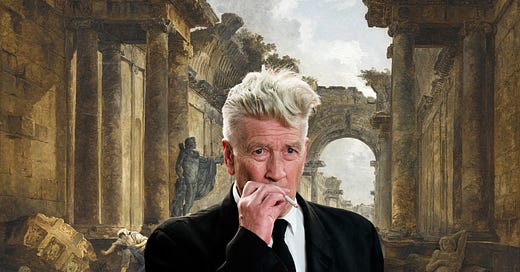David Lynch is dead. Already, HBO has put his films on its homepage for those slackers quietly looking to finally watch the late master.
Lynch was alive last week, and while he had plenty of fans, we didn’t see this much outpouring of love. Would we have heard this much praise if he had released a new film? After Norm MacDonald died, his reception was never better: thousands of his clips proliferated online, dominating YouTube shorts and social media avatars. Robin Williams’ movie sales and pirated downloads soared when he took his life. Why does it seem like we gain so much more respect for someone after they die?
Death adds a note of finality—there can be no more from them after this—or perhaps even of completion. Wallace Stevens, a poet of the American sublime like Lynch, wrote:
Death is the mother of beauty; hence from her,
Alone, shall come fulfilment to our dreams
And our desires.
In a novel I’m writing about recent debates over artistic taste, I will consider how ruins only came to be a subject for painters in the baroque age and after. They weren’t the first landscapes to be taken up for artistic depiction—the mythological scenes of Nicolas Poussin (1594-1665) and Claude Lorrain (1600-1682) preceded them. Those artists wanted to give us glimpses into the Golden Age spoken of by Homer, Hesiod, Virgil, and Ovid. But later artists eventually took the myths out of the paintings, turning the real landscapes of the earth into subjects.
In the next century, with the works of Giovanni Paolo Panini (1691-1765) and Hubert Robert (1733-1808), we see a return to the classical, but in ruins. These paintings say in a single image what the entire systems of Vico and Spengler or the annals of Polybius and Gibbon struggle to say over thousands of pages.
They dramatize the futility of human ambitions and aims. Every human civilization can expect only a ruinous end. All human life is shadowed by death. Aristocracies greater than yours have fallen to the passions of the mob; all virtues no matter how sanctified and enshrined have decayed into vices. The vicious cycle of the ages is as ironclad as the seasons of Ceres, Panini says, and the whole of human history can be represented by his wheat-hewing scythe.

Just a few years after the Louvre was built, Hubert Robert painted what it would look like a thousand years hence—as dilapidated as any of the cities Rome built around the Mediterranean.
Yet how pure do things look in this light. At the very same moment in which the whole secret of human decline is revealed, we’re also made aware of how beautiful it is through the power of the work of art. Why does such a force of profundity and gravity come over human affairs when they lie cracked and smoldering?
Death stills the competitive compulsions and arrests an entity sub specie aeternatatis. A statue in decay is more of an artwork to us than when it was “used” by true believers as a totem of worship, dressed in garlands and covered in gaudy paint. A half-sunken coliseum is more sublime to us than when it was filled with masses cheering on lions and games. The political forum is nobler in its parched and ragged remains than when it was the thoroughfare of corrupt lawmakers.
Lynch, at the end of Eraserhead, suggests that (a) death might be a beautiful thing. Much is being made right now about his emphysema, and his unapologetic defense last year of his love for cigarettes even after quitting. Lynch knew what he liked in life, and knew what really mattered: not mere quantifiable longevity, but the substance of life, its immortals, the work and the art.
As we see in Panini’s allegory, the lady of wisdom sighs a happy sigh over the scene, because she preserves within herself the harvest of all those toils: the development of a meta-philosophy and a meta-religion above all those theories and faiths, the supreme Aesthetic Judgment, the highest criterion.
The beauty of human life in its consummation, the permanency bestowed to a human when they have succumbed to their destiny, unites that particle with the whole of fate. It is through mortality that mankind accesses its highest moment of grace, because there it discovers the good taste of knowing when to stop.





